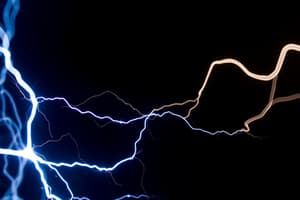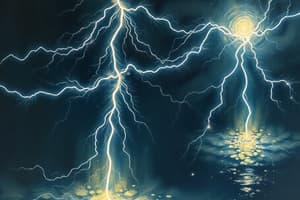Podcast
Questions and Answers
Which of the following statements accurately describes the relationship between mass and electric charge?
Which of the following statements accurately describes the relationship between mass and electric charge?
- Charge can exist without mass, but mass cannot exist without charge.
- Mass can be negative, while charge is always positive.
- Charge always exists with mass, but mass can exist without charge. (correct)
- Mass and charge are both independent of speed and always exist together.
An isolated system contains several charged particles. If a reaction occurs within the system that rearranges these particles, which of the following statements must be true according to the principle of conservation of charge?
An isolated system contains several charged particles. If a reaction occurs within the system that rearranges these particles, which of the following statements must be true according to the principle of conservation of charge?
- The algebraic sum of all charges must remain constant. (correct)
- The sum of the magnitudes of all charges must remain constant.
- The total negative charge must remain constant, but the total positive charge can change.
- The total positive charge must remain constant, but the total negative charge can change.
A subatomic particle is observed to have a charge of $3.2 \times 10^{-19}$ coulombs. According to the principle of charge quantization, what can be concluded about this observation?
A subatomic particle is observed to have a charge of $3.2 \times 10^{-19}$ coulombs. According to the principle of charge quantization, what can be concluded about this observation?
- The particle's charge violates the principle of charge quantization; such charges are not possible.
- The particle's charge is equal to the fundamental charge, indicating it could be an electron.
- The particle's charge is a fraction of the fundamental charge, suggesting the existence of a free quark.
- The particle's charge is twice the fundamental charge and is therefore possible. (correct)
Which of the following scenarios best illustrates the principle of charge conservation?
Which of the following scenarios best illustrates the principle of charge conservation?
In an experiment, two initially neutral objects are rubbed together. After separation, Object A has a net positive charge. What can be definitively concluded about Object B?
In an experiment, two initially neutral objects are rubbed together. After separation, Object A has a net positive charge. What can be definitively concluded about Object B?
An object has a net charge of $-4.8 \times 10^{-19}$ C. How many excess electrons does the object possess?
An object has a net charge of $-4.8 \times 10^{-19}$ C. How many excess electrons does the object possess?
Which of the following is a direct consequence of the fact that electric charge is quantized?
Which of the following is a direct consequence of the fact that electric charge is quantized?
A nuclear reaction involves the decay of Uranium-238 ($^{238}{92}U$) into Thorium-234 ($^{234}{90}Th$) and an alpha particle ($^{4}_{2}He$). How does this reaction demonstrate the conservation of charge?
A nuclear reaction involves the decay of Uranium-238 ($^{238}{92}U$) into Thorium-234 ($^{234}{90}Th$) and an alpha particle ($^{4}_{2}He$). How does this reaction demonstrate the conservation of charge?
A metallic sphere with a charge of +4q is brought into contact with an identical uncharged metallic sphere. What is the charge on each sphere after they are separated?
A metallic sphere with a charge of +4q is brought into contact with an identical uncharged metallic sphere. What is the charge on each sphere after they are separated?
A neutral metal rod is charged by induction using a negatively charged balloon. Which of the following describes the charge distribution on the rod during the process?
A neutral metal rod is charged by induction using a negatively charged balloon. Which of the following describes the charge distribution on the rod during the process?
During charging by friction, a rubber rod becomes negatively charged after being rubbed with fur. What happens to the fur?
During charging by friction, a rubber rod becomes negatively charged after being rubbed with fur. What happens to the fur?
A student calculates the charge on an object to be $3.5 \times 10^{-19}$ C. Given that the elementary charge (e) is approximately $1.602 \times 10^{-19}$ C, is this charge possible?
A student calculates the charge on an object to be $3.5 \times 10^{-19}$ C. Given that the elementary charge (e) is approximately $1.602 \times 10^{-19}$ C, is this charge possible?
Three identical metal spheres, A, B, and C, are arranged such that A and B are touching each other but not touching C, and all are insulated from their surroundings. Initially, A has a charge of +4q, B is neutral, and C has a charge of -2q. If A and B are separated and then C is touched to A, what is the final charge on sphere A?
Three identical metal spheres, A, B, and C, are arranged such that A and B are touching each other but not touching C, and all are insulated from their surroundings. Initially, A has a charge of +4q, B is neutral, and C has a charge of -2q. If A and B are separated and then C is touched to A, what is the final charge on sphere A?
Two objects are rubbed together, and object X gains $5 \times 10^{12}$ electrons. What is the resulting charge on object Y, given that the elementary charge, e, is $1.602 \times 10^{-19}$ C?
Two objects are rubbed together, and object X gains $5 \times 10^{12}$ electrons. What is the resulting charge on object Y, given that the elementary charge, e, is $1.602 \times 10^{-19}$ C?
During an experiment, a student observes that a charged rod attracts small pieces of paper. Which of the following best explains this phenomenon?
During an experiment, a student observes that a charged rod attracts small pieces of paper. Which of the following best explains this phenomenon?
A positively charged rod is used to charge a metal sphere by induction. The sphere is initially neutral and isolated. After the process, what is the net charge on the sphere?
A positively charged rod is used to charge a metal sphere by induction. The sphere is initially neutral and isolated. After the process, what is the net charge on the sphere?
Flashcards
Electrostatics
Electrostatics
The study of electric charges at rest.
Electrodynamics
Electrodynamics
The study of electric charges in motion (electric current).
Electric Charge
Electric Charge
An intrinsic property of matter; measured in Coulombs (C).
Coulomb (C)
Coulomb (C)
Signup and view all the flashcards
Like Charges
Like Charges
Signup and view all the flashcards
Opposite Charges
Opposite Charges
Signup and view all the flashcards
Charge Conservation
Charge Conservation
Signup and view all the flashcards
Quantization of Charge
Quantization of Charge
Signup and view all the flashcards
Formula for Quantization
Formula for Quantization
Signup and view all the flashcards
Charging by Conduction
Charging by Conduction
Signup and view all the flashcards
Charge Distribution by Contact
Charge Distribution by Contact
Signup and view all the flashcards
Charging by Induction
Charging by Induction
Signup and view all the flashcards
Charging by Induction (Earthing)
Charging by Induction (Earthing)
Signup and view all the flashcards
Charging by Friction
Charging by Friction
Signup and view all the flashcards
Charge and Mass Transfer/Conservation of Charge
Charge and Mass Transfer/Conservation of Charge
Signup and view all the flashcards
Study Notes
Introduction to Class 12th Physics
- Class 12th Physics starts with a focus on improvement.
- The first chapter, Electric Charges and Fields, falls under electrostatics within electromagnetism.
- Resources include website access, downloadable notes, and numerical problems with solutions.
Electromagnetism Overview
- Electromagnetism forms a significant part of the class 12th physics syllabus.
- It comprises electrostatics (charges at rest) and electrodynamics (charges in motion).
- Electrodynamics covers electric current, magnetism, electromagnetic induction, and alternating current.
- Syllabus includes wave optics, ray optics (from class 11th), and modern physics.
Electric Charge Basics
- Charge is an intrinsic, fundamental property, like mass.
- Ancient Greeks around 600 BC noted attraction after rubbing substances.
- 'q' symbolizes charge, measured in coulombs (C).
- Charge is a scalar quantity.
- Two types of charge exist: positive and negative.
- Like charges repel; opposite charges attract.
Charge vs. Mass
- Charge requires mass, but mass can exist without charge.
- Charge can be positive or negative, mass is always positive.
- Mass varies with speed: m=m0/√(1−v2/c2) where m is relativistic mass, m0 is rest mass, v is velocity, and c is the speed of light.
- Charge is speed-independent.
Conservation of Charge
- Charge is neither created nor destroyed, only transferred.
- Total charge in an isolated system remains constant: Qtotal = Q1 + Q2 + Q3 = constant.
- Charge conservation applies to radioactive decay equations and nuclear reactions.
- Experimentally verified.
Quantization of Charge
- Quantization means existence in fixed amounts.
- Charge is quantized, in discrete multiples of the fundamental charge unit (e).
- The smallest independent charge is that of an electron (e), approximately 1.6 x 10^-19 coulombs, also called the fundamental charge.
- Smaller charges (quarks) exist but are not independent.
- Charge exists in integral multiples of the elementary charge (e).
Equation for Quantization of Charge
- q = ±ne, where q is the charge on a body, n is an integer, and e is the charge on an electron.
- Example: Determining if a charge of 8 x 10^-18 coulombs is transferable.
- Use q = ne to find 'n'; if 'n' is an integer, the charge can be transferred.
Methods of Charging
- Three primary methods exist: conduction, induction, and friction.
Charging by Conduction
- Direct contact charging between charged and neutral/differently charged bodies.
- Electrons transfer from the body with excess electrons.
- Identical conductors distribute charge equally: charge q becomes q/2 on each after separation.
- Formula: Touching charge q to an uncharged body results in q/2 on both after separation.
Charging by Induction
- Charging without direct contact by proximity to a charged object.
- Involves polarization: charge redistribution within a neutral object.
- Procedure: Bring a charged body near a neutral conductor, causing polarization.
- Opposite charges accumulate nearest the charged body.
- Connect a conducting body (B) to the far side of the neutral conductor.
- Separate A and B to achieve charging by induction.
Charging by Induction Through Earthing
- Grounding replaces a second body in induction.
- Polarize the object, then connect to ground to remove/supply electrons.
- Disconnect from ground, then remove the inducing charge, leaving a net charge.
Charging by Friction
- Commonly used for insulators.
- Rubbing transfers electrons due to frictional heat providing ionization energy.
- Transfer direction depends on electropositivity/electronegativity.
- Example: Plastic scale rubbed on hair picking up paper.
- Charge transfer involves mass transfer due to the mass of electrons.
- Charge of isolated system remains constant.
Next Steps
- The next lecture will cover Coulomb's Law.
Studying That Suits You
Use AI to generate personalized quizzes and flashcards to suit your learning preferences.



